Tina Memo No. 2003-003
Internal Report
Products and Convolutions of Gaussian Probability Density
Functions
P.A. Bromiley
Last updated
14 / 8 / 2014
Imaging Sciences Research Group, Institute of Population Health,
School of Medicine, University of Manchester,
Stopford Building, Oxford Road,
Manchester, M13 9PT.
�
Products and Convolutions of Gaussian Probability
Density Functions
Imaging Sciences Research Group, Institute of Population Health,
School of Medicine, University of Manchester,
P. A. Bromiley
Manchester, M13 9PT, UK
paul.bromiley@manchester.ac.uk
Abstract
It is well known that the product and the convolution of Gaussian probability density functions (PDFs)
are also Gaussian functions. This document provides proofs of this for several cases; the product of
two univariate Gaussian PDFs, the product of an arbitrary number of univariate Gaussian PDFs, the
product of an arbitrary number of multivariate Gaussian PDFs, and the convolution of two univari-
ate Gaussian PDFs. These results are useful in calculating the effects of smoothing applied as an
intermediate step in various algorithms.
1 The Product of Two Univariate Gaussian PDFs
Let f (x) and g(x) be Gaussian PDFs with arbitrary means µf and µg and standard deviations σf and σg
f (x) =
1
√2πσf
−
e
(x−µf )2
2σ2
f
and g(x) =
(x−µg )2
2σ2
g
1
√2πσg
−
e
Their product is
Examine the term in the exponent
f (x)g(x) =
− (x−µf )2
2σ2
f
+
e
1
2πσf σg
(x−µg )2
g
2σ2
β =
(x − µf )2
2σ2
f
+
(x − µg)2
2σ2
g
Expanding the two quadratics and collecting terms in powers of x gives
(σ2
f + σ2
g)x2 − 2(µf σ2
β =
g + µgσ2
2σ2
f σ2
g
f )x + µ2
f σ2
g + µ2
gσ2
f
Dividing through by the coefficient of x2 gives
x2 − 2
β =
gσ2
f
g+µ2
f σ2
µ2
σ2
f +σ2
g
g+µgσ2
µf σ2
σ2
f +σ2
f
x +
g
σ2
f σ2
σ2
f +σ2
g
g
2
This is again a quadratic in x, and so Eq. 2 is a Gaussian function. Compare the terms in Eq. 5 to a the usual
Gaussian form
P (x) =
1
√2πσ
e− (x−µ)2
2σ2 =
1
√2πσ
e− (x2−2µx+µ2 )
2σ2
Since a term ǫ that is independent of x can be added to complete the square in β, this is sufficent to complete the
proof in cases where the normalisation can be ignored. The product of two Gaussian PDFs is proportional to a
Gaussian PDF with a mean that is half the coefficient of x in Eq. 5 and a standard deviation that is the square
root of half of the denominator i.e.
σf g =s σ2
f σ2
g
σ2
f + σ2
g
and µf g =
g + µgσ2
µf σ2
f
σ2
f + σ2
g
�
i.e. the variance σ2
g, and the mean µf g is the
sum of the individual means µf and µg weighted by their variances. In general, the product is not itself a PDF
as, due to the presence of the scaling factor, it will not have the correct normalisation.
f g is twice the harmonic mean of the individual variances σ2
f and σ2
The product f (x)g(x) can now be written in the usual Gaussian form directly, with an unknown scaling constant
(this may be sufficient in cases where renormalisation can be applied). Alternatively, proceeding from Eq. 5,
suppose that ǫ is the term required to complete the square in β i.e.
ǫ = µf σ2
g+µgσ2
σ2
f +σ2
f
g 2
− µf σ2
g+µgσ2
σ2
f +σ2
f
g 2
2σ2
f σ2
g
f +σ2
g)
(σ2
= 0
Adding this term to β gives
x2 − 2x
β =
g+µgσ2
µf σ2
σ2
f +σ2
f
+ µf σ2
g+µgσ2
σ2
f +σ2
f
g 2
g
2σ2
f σ2
g
f +σ2
g)
(σ2
+
g+µ2
f σ2
µ2
σ2
f +σ2
f
gσ2
g − µf σ2
2σ2
f σ2
g
f +σ2
g)
(σ2
g+µgσ2
σ2
f +σ2
f
g 2
After some manipulation, this reduces to
β = x −
Substituting back into Eq. 2 gives
f
g 2
µf σ2
g+µgσ2
σ2
f +σ2
σ2
f σ2
σ2
f +σ2
g
g
2
+
(µf − µg)2
2(σ2
f + σ2
g)
=
(x − µf g)2
2σ2
f g
+
(µf − µg)2
2(σ2
f + σ2
g)
f (x)g(x) =
1
2πσf σg
exp"−
(x − µf g)2
2σ2
f g
# exp"−
g)#
(µf − µg)2
2(σ2
f + σ2
Multiplying by σf g/σf g and rearranging gives
=
1
√2πσf g
exp"−
(x − µf g)2
2σ2
f g
#
exp"−
g)#
(µf − µg)2
2(σ2
f + σ2
f + σ2
g)
Therefore, the product of two Gaussians PDFs f (x) and g(x) is a scaled Gaussian PDF
1
q2π(σ2
exp"−
f (x)g(x) =
Sf g√2πσf g
(x − µf g)2
2σ2
f g
#
where
σf g =s σ2
f σ2
g
σ2
f + σ2
g
and µf g =
µf σ2
g + µgσ2
f
σ2
f + σ2
g
(1)
and the scaling factor S is itself a Gaussian PDF on both µf and µg with standard deviation qσ2
f + σ2
g
Sf g =
These can be written more conveniently as
1
σ2
f g
=
1
σ2
f
+
1
σ2
g
, µf g = µf
σ2
f
q2π(σ2
g! σ2
µg
σ2
+
f g
1
f + σ2
g)
exp"−
g)#
(µf − µg)2
2(σ2
f + σ2
and Sf g =
1
r2π
g
σ2
f σ2
σ2
f g
exp"−
1
2
(µf − µg)2
σ2
f σ2
g
σ2
f g#
(2)
It is much easier to generate a proof by induction for the scaling factor of products of larger numbers of Gaussians
if it is written in the form of a sum of terms, each of which involves a single subscript i.e. the parameters of a
single Gaussian PDF. Appendix A provides the necessary proof, giving
1
2 µ2
f
σ2
f
+
µ2
g
g −
σ2
µ2
f g
σ2
f g!#
(3)
Sf g =
exp"−
1
r2π
g
σ2
f σ2
σ2
f g
3
�
2 The Product of n Univariate Gaussian PDFs
Let N (µ, σ) represent a Gaussian PDF with mean µ and standard deviation σ. Let subscript i refer to an
individual Gaussian PDF in a product of n univariate Gaussian PDFs. Furthermore, let the subscript i = 1...n
refer to the parameters of the distribution that is the product n individual Gaussian PDFs and subscripts of the
form i = (1...n − 1)n refer to the parameters of a distribution that is the product of two Gaussian PDFs, one of
which is itself the product of n − 1 Gaussian PDFs. Therefore, the results from Section 1 can be applied to the
first two Gaussian PDFs in the product of n Gaussian PDFs to produce a Gaussian PDF and a scaling factor. The
remaining n − 2 PDFs can then be introduced iteratively using the same expressions i.e.
N (µi, σi) = Si=1...2N (µi=1...2, σi=1...2)
N (µi, σi)
n
Yi=1
= Si=1...2S(i=1...2)3N (µ(i=1...2)3, σ(i=1...2)3)
N (µi, σi) = ...
n
Yi=3
Yi=4
n
= Si=1...2...S(...((i=1...2)3)...n)N (µ(...((i=1...2)3)...n), σ(...((i=1...2)3)...n)) = Si=1...nN (µi=1...n, σi=1...n)
(4)
(5)
(6)
Applying the expression for the standard deviation from Eq. 2 iteratively gives
1
σ2
i=1...n
=
1
σ2
i=1...n−1
+
1
σ2
n
=
1
σ2
i=1...n−2
+
1
σ2
n−1
+
1
σ2
n
= ... =
n
Xi=1
1
σ2
i
Similarly, the mean is given by
µi=1...n = µi=1...n−1
i=1...n−1
σ2
+
µn
σ2
n σ2
i=1...n = µi=1...n−2
i=1...n−2
σ2
i=1...n−1
i=1...n−1
+
µn
σ2
n σ2
i=1...n
+
σ2
µn−1
σ2
n−1 σ2
i=1...n = ... =" n
Xi=1
µi
σ2
i # σ2
i=1...n
= µi=1...n−2
i=1...n−2
σ2
+
µn−1
σ2
n−1
+
By inspection of Eq. 3, state the form
µn
σ2
n σ2
Si=1...n =
1
(2π)(n−1)/2s σ2
Qn
i=1...n
i=1 σ2
i
exp"−
1
2 n
Xi=1
µ2
i
i −
σ2
µ2
σ2
i=1...n
i=1...n!#
for the scaling factor. Similarly, using Eq. 4 to manipulate some of the standard deviation terms,
S(i=1...n)(n+1) =
1
(2π)(1/2)s σ2
i=1...n+1
σ2
i=1...nσ2
n+1
exp"−
1
2 µ2
σ2
i=1...n
i=1...n
+
n+1
µ2
n+1 −
σ2
µ2
σ2
(i=1...n)(n+1)
(i=1...n)(n+1)!#
The scaling factor is the product of individual scaling factors for each pairwise multiplication, so
Si=1...n+1 = Si=1...nS(i=1...n)(n+1) =
This gives two terms to deal with: First, the standard devation term
σ2
i=1...n+1
i=1...nσ2
σ2
n+1
exp"−
1
2 n
Xi=1
µ2
i
σ2
i
+
n+1
µ2
n+1 −
σ2
µ2
σ2
(i=1...n)(n+1)
(i=1...n)(n+1)!#
i=1...n
i=1 σ2
i
1
(2π)n/2s σ2
Qn
Qn
σ2
i=1 σ2
i
i=1...n
i=1...nσ2
σ2
σ2
i=1...n+1
n+1
=
i=1 σ2
i
σ2
n+1Qn
σ2
i=1...n+1
= Qn+1
i=1 σ2
i
i=1...n+1
σ2
Second, the term in the exponent; using Eq. 5 gives
µ2
σ2
(i=1...n)(n+1)
(i=1...n)(n+1)
=
µ2
σ2
i=1...n
i=1...n
+
µ2
σ2
n+1
n+1
=
µ2
i
σ2
i
n
Xi=1
+
µ2
σ2
n+1
n+1
=
µ2
i
σ2
i
n+1
Xi=1
=
µ2
σ2
i=1...n+1
i=1...n+1
Therefore
µ2
i
σ2
i
n
Xi=1
+
n+1
µ2
n+1 −
σ2
µ2
σ2
(i=1...n)(n+1)
(i=1...n)(n+1)
=
n+1
Xi=1
µ2
i
i −
σ2
µ2
σ2
(i=1...n+1)
(i=1...n+1)
4
�
So
Si=1...n+1 =
1
(2π)n/2s σ2
i=1...n+1
i=1 σ2
i
Qn+1
exp"−
1
2 n+1
Xi=1
µ2
i
i −
σ2
µ2
σ2
i=1...n+1
i=1...n+1!#
which, together with Eq. 3, constitutes a proof by induction of Eq. 6. As with the product of two univariate
Gaussian PDFs, the scaling factor is a Gaussian function. However, it is not a PDF, as it does not have the correct
normalisation.
3 The Product of n Multivariate Gaussian PDFs
The multivariate Gaussian PDF can be written as
p(x) =
1
(2π)d/2p|V |
exp−
1
2
(x − µ)T V −1(x − µ)
where d is the dimensionality of x, µ is the d-dimensional mean vector, and V is the d-by-d dimensional covariance
matrix; this document adopts the standard notation of using bold face symbols to represent vectors and matrices.
The Gaussian PDF can also be written in canonical notation as
where
Λ = V −1
, η = V −1µ and ζ = −
So the product of n Gaussian PDFs i = 1...n is
p(x) = expζ + ηT x −
1
2
xT Λx
1
2d log 2π − log|Λ| + ηT Λ−1η
ηi!T
x −
xT n
Xi=1
1
2
n
n
n
1
Yi=1
ζi=1...n =
ζi = −
pi(x) = exp
ζi=1...n + n
Xi=1
2 nd log 2π −
Xi=1
Xi=1
pi(x) = exp
ηi!T
ζi=1...n + ζn − ζn + n
Xi=1
= exp(ζi=1...n − ζn)expζn + ηT
n x −
Λ−1
Λi! x
i ηi!
Λi! x
n
ηT
i
Xi=1
xT n
Xi=1
x −
xT Λnx
1
2
1
2
log |Λi| +
where
So
where
and
n
Yi=1
(7)
(8)
(9)
ηi
n
n
Λn =
Λi
, ηn =
Xi=1
Xi=1
2d log 2π − log|Λn| + ηT
1
n
Λ−1
n ηn
ζn = −
Comparing Eqs. 7, 9 and 8 shows that the result is, as in the previous sections, a scaled Gaussian PDF over x
with a mean vector and covariance matrix given by
V −1
n =
n
Xi=1
V −1
i
and V −1
n µn =
V −1
i µi
n
Xi=1
The scaling factor is again a Gaussian function.
5
�
4 The Convolution of Two Univariate Gaussian PDFs
We wish to find the convolution of two Gaussian PDFs
f (x) =
1
√2πσf
−
e
(x−µf )2
2σ2
f
and g(x) =
(x−µg )2
2σ2
g
1
√2πσg
−
e
in the most general case i.e. non-identical means. The convolution of two functions f (t) and g(t) over a finite
range1 is defined as
Z x
0
f (x − τ )g(τ )dτ = f ⊗ g
However, the usual approach is to use the convolution theorem [2],
where F is the Fourier transform
F −1[F (f (x))F (g(x))] = f (x) ⊗ g(x)
F (f (x)) =Z ∞
f (x)e−2πikx dx
−∞
and F −1 is the inverse Fourier transform
Using the transformation
F −1(F (k)) =Z ∞
−∞
F (k)e2πikx dk
x′ = x − µf
the Fourier transform of f (x) is given by
F (f (x)) =
Using Euler’s formula [2],
1
√2πσf Z ∞
−∞
− x′2
2σ2
f e−2πik(x′−µf ) dx′ =
e
e−2πikµf
√2πσf Z ∞
−∞
− x′2
2σ2
f e−2πikx′
e
dx′
we can split the term in ex′
to give
F (f (x)) =
e−iθ = cos θ − i sin θ
e−2πikµf
√2πσf Z ∞
−∞
− x′2
2σ2
f [cos(2πkx′) − i sin(2πkx′)] dx′
e
The term in sin (x′) is odd and so its integral over all space will be zero, leaving
F (f (x)) =
This integral is given in standard form in [1]
e−2πikµf
√2πσf Z ∞
−∞
− x′2
2σ2
f cos(2πkx′) dx′
e
e−at2
cos (2xt) dt =
Z ∞
0
1
2r π
a
e− x2
a
and so
F (f (x)) = e−2πikµf e−2π2σ2
f k2
The second term in this expression is a Gaussian PDF in k: the Fourier transform of a Gaussian PDF is another
Gaussian PDF. The first term is a phase term accounting for the mean of f (x) i.e. its offset from zero. The Fourier
transform of g(x) will give a similar expression, and so
F (f (x))F (g(x)) = e−2πikµf e−2π2σ2
f k2
e−2πikµg e−2π2σ2
gk2
1In practice, convolutions are more often performed over an infinite range
Z ∞
−∞
f (x − τ )g(τ )dτ = f ⊗ g
6
= e−2πik(µf +µg)e−2π2(σ2
f +σ2
g)k2
�
Comparing Eq. 25 to Eq. 24, we can see that it is the Fourier transform of a Gaussian PDF with mean and
standard deviation
and therefore, since the Fourier transform is invertible,
µf ⊗g = µf + µg
and σf ⊗g =qσ2
f + σ2
g
Pf ⊗g(x) = F −1[F (f (x))F (g(x))] =
(x−(µf +µg ))2
2(σ2
f
+σ2
g )
−
e
1
f + σ2
g)
q2π(σ2
It may be worth noting a general result at this point; the area under a convolution is equal to the product of the
areas under the factors
Z ∞
−∞
−∞
−∞Z ∞
(f ⊗ g)dt =Z ∞
=Z ∞
f (u)Z ∞
f (u)duZ ∞
Z ∞
f (u)g(t − u)du dt
g(t − u)dt du
g(t)dt
−∞
−∞
−∞
−∞
Therefore, the preservation of the normalisation when convolving PDFs i.e. the fact that the convolution is also a
PDF, normalised such that the area under the function is equal to unity, is a special case rather than being true
in general.
5 Summary
It is well known that the product and the convolution of a pair of Gaussian PDFs are also Gaussian. In the case
of the product of two univariate Gaussian PDFs N (µf , σf ) and N (µg, σg), the result is a scaled Gaussian PDF
where the scaling factor is itself a Gaussian PDF on both µf and µg
N (µf , σf )N (µg, σg) =
Sf g√2πσf g
exp"−
(x − µf g)2
2σ2
f g
# where
exp"−
g
1
2
1
σ2
f g
=
1
σ2
f
+
1
σ2
g
, µf g = µf
σ2
f
+
(µf − µg)2
σ2
f σ2
g
σ2
f g#
µg
σ2
g! σ2
f g
and Sf g =
1
r2π
σ2
f σ2
σ2
f g
It should be noted that this result is not the PDF of the product of two Gaussian random variates; in that case,
the product normal distribution applies.
The product of n univariate Gaussian PDFs is given by
N (µi, σi) =
n
Yi=1
Si=1...n
i=1...n
p2πσ2
exp−
and Si=1...n =
(x − µi=1...n)2
2σ2
i=1...n
where
1
σ2
i=1...n
1
(2π)(n−1)/2s σ2
Qn
i=1...n
i=1 σ2
i
exp"−
n
=
Xi=1
2 n
Xi=1
1
1
σ2
i
µ2
i
i −
σ2
µi
σ2
i # σ2
i=1...n
, µi=1...n =" n
Xi=1
i=1...n!#
i=1...n
µ2
σ2
i.e. is a Gaussian PDF scaled by a Gaussian function.
The product of n multivariate Gaussian PDFs is given by
n
Yi=1
N (µi, V −1
i
) = exp(ζi=1...n − ζn)expζn + ηT
n x −
1
2
xT Λnx
where
Λi = V −1
i
, ηi = V −1
i µi
, Λn =
Xi=1
2d log 2π − log|Λn| + ηT
1
n
ζn = −
7
n
Λi
, ηn =
ηi
,
n
Xi=1
and
Λ−1
n ηn
�
ζi=1...n =
ζi = −
1
2 nd log 2π −
n
Xi=1
n
Xi=1
log |ηi| +
ηT
i
Λ−1
i ηi!
n
Xi=1
i.e. a Gaussian PDF scaled by a Gaussian function.
The convolution of two Gaussian PDFs is a Gaussian PDF with mean and standard deviation
µf ⊗g = µf + µg
and σf ⊗g =qσ2
f + σ2
g
These results can be useful in a number of applications; for example, the convolution of Gaussian distributions
freqently occurs in smoothing applied as an intermadiate step in various machine vision algorithms. Products of
Gaussian PDFs may occur during the application of Bayes theorem, and in some problems related to Gaussian
processes.
6 Acknoweldgements
Thanks are due to David Kirchheimer, University of Bristol, for pointing out the importance of the product of an
arbitrary number of Gaussian PDFs and providing Matlab code for numerical testing of the results. Thanks are
also due to Thomas Dent, Institute for Gravitational Physics (Albert Einstein Institute), Hannover, Germany, for
pointing out several typographical errors.
References
[1] M Abramowitz and I A Stegun. Handbook of Mathematical Functions. National Bureau of Standards, Wash-
ington DC, 1972.
[2] M L Boas. Mathematical Methods in the Physical Sciences. John Wiley and Sons Ltd., 1983.
A Rewriting the Scaling Factor
Using Eq. 4 and 5
So
µ2
σ4
i=1...n
i=1...n
= n
Xi=1
i !2
µi
σ2
=
µ2
i
σ4
i
n
Xi=1
+ 2
n−1
Xi=1
n
Xj=i+1
µiµj
σ2
i σ2
j
2
n−1
Xi=1
n
Xj=i+1
µiµj
i σ2
σ2
j
=
i=1...n
µ2
i=1...n −
σ4
µ2
i
σ4
i
n
Xi=1
The terms in the exponent of the scaling factor for the product of univariate Gaussians take the form
n−1
Xi=1
n
Xj=i+1
(µi − µj)2
σ2
i σ2
j
σ2
i=1...n =
n−1
Xi=1
n
Xj=i+1 µ2
i
σ2
i σ2
j −
2µiµj
σ2
i σ2
j
+
µ2
j
σ2
i σ2
j! σ2
i=1...n
which, substituting the above expression for the cross term,
=
n−1
Xi=1
=
n
i
σ2
i σ2
j
Xj=i+1 µ2
Xj=i+1
Xi=1
n−1
µ2
n
σ2
i=1...n! +
i ! −
µ2
σ2
σ2
i=1...n
σ4
µ2
i
σ4
i
n
Xi=1
σ2
i=1...n −
µ2
σ4
i=1...n
i=1...n
σ2
i=1...n
i=1...n
i=1...n
=
n
Xi=1 µ2
i
σ2
i −
µ2
σ2
i=1...n
i=1...n
σ2
i=1...n +
µ2
j
σ2
i σ2
j
i σ2
i=1...n
σ2
i σ2
j
+
8
�
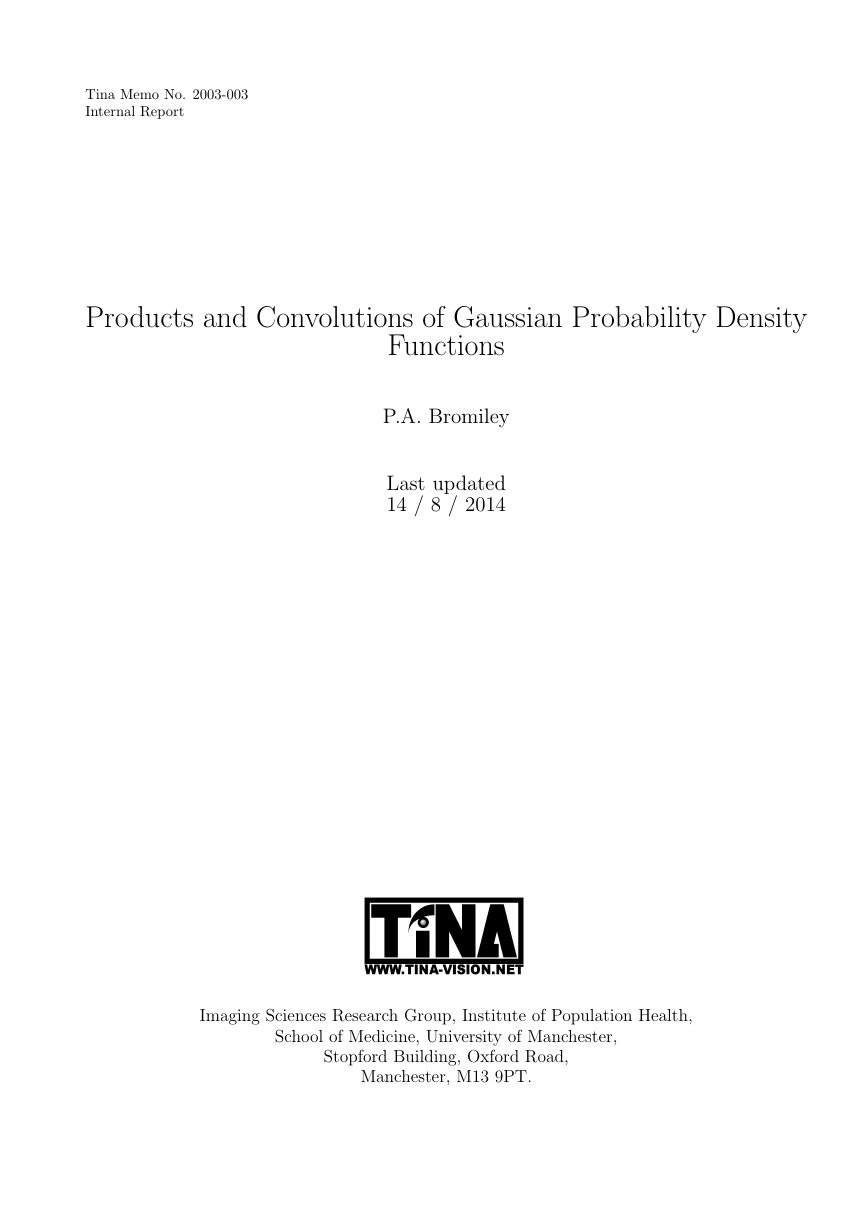
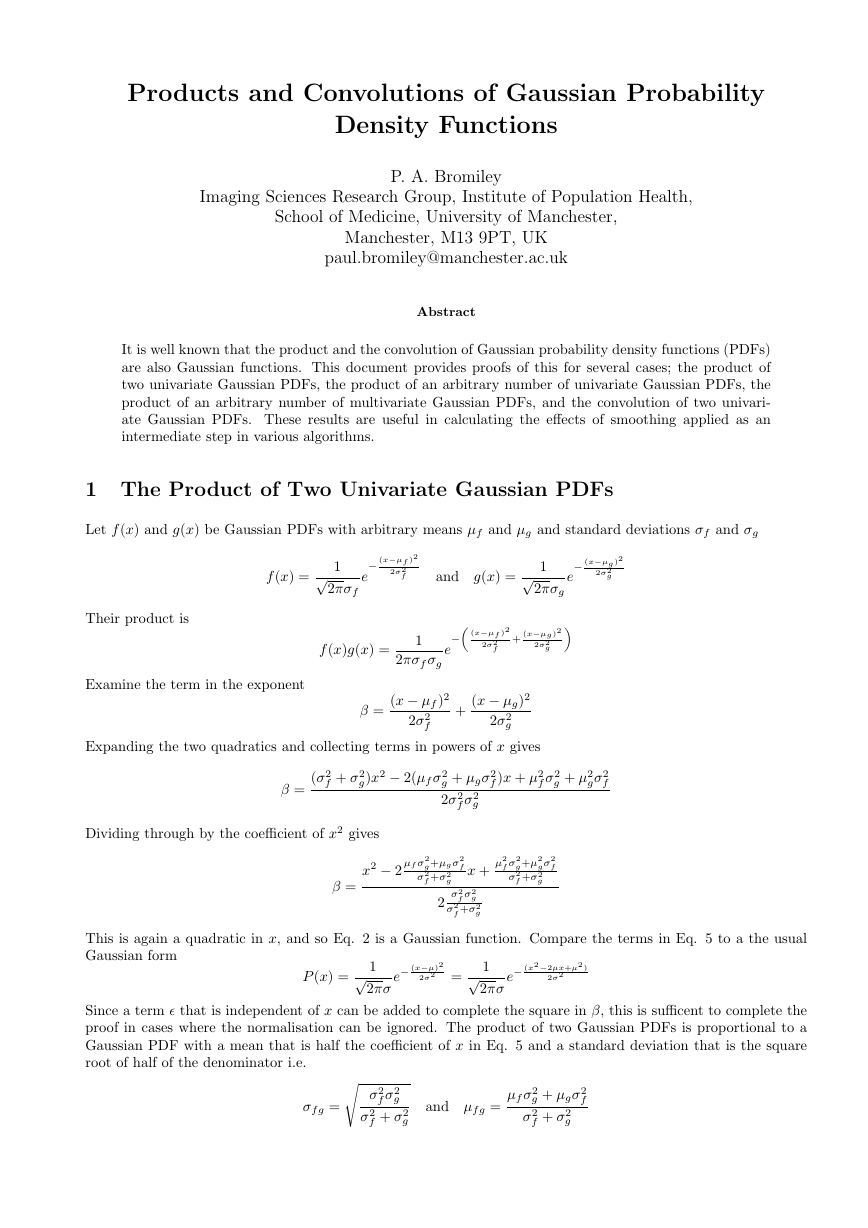
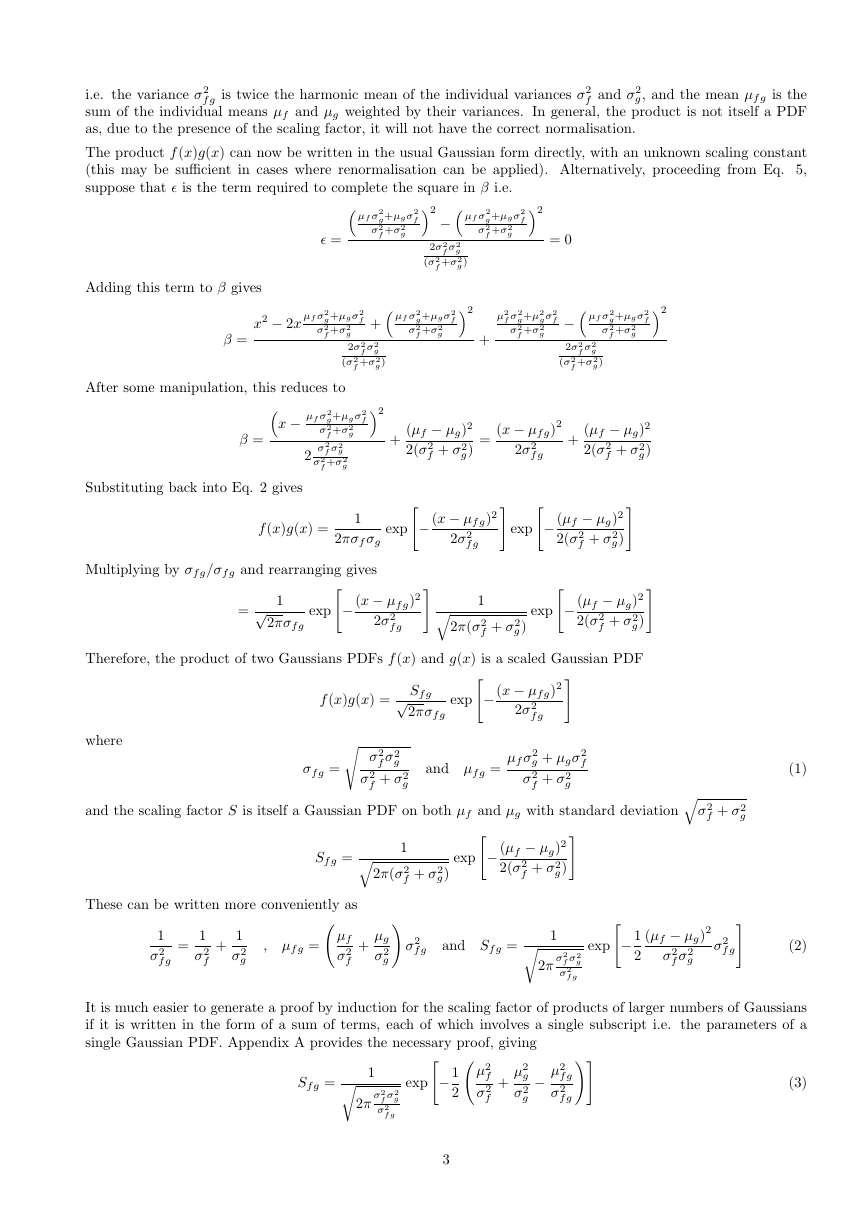

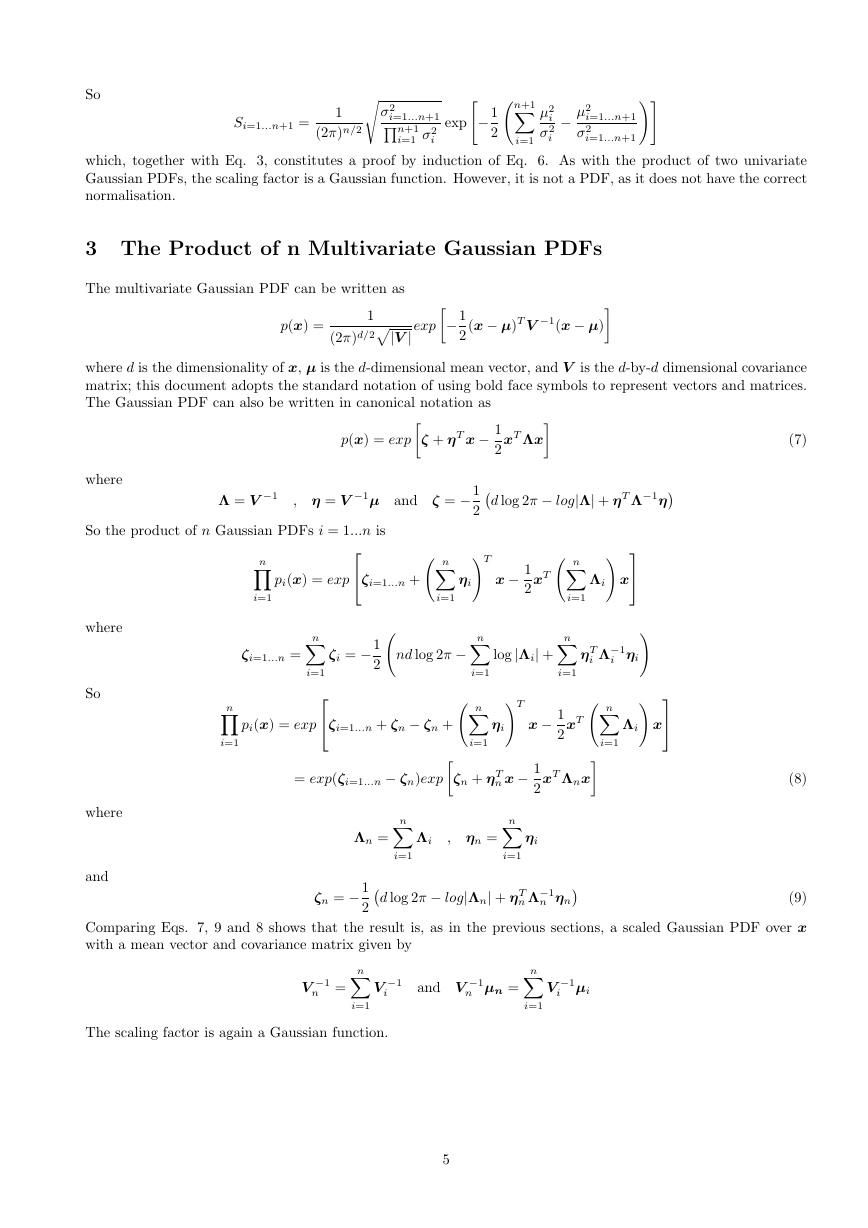

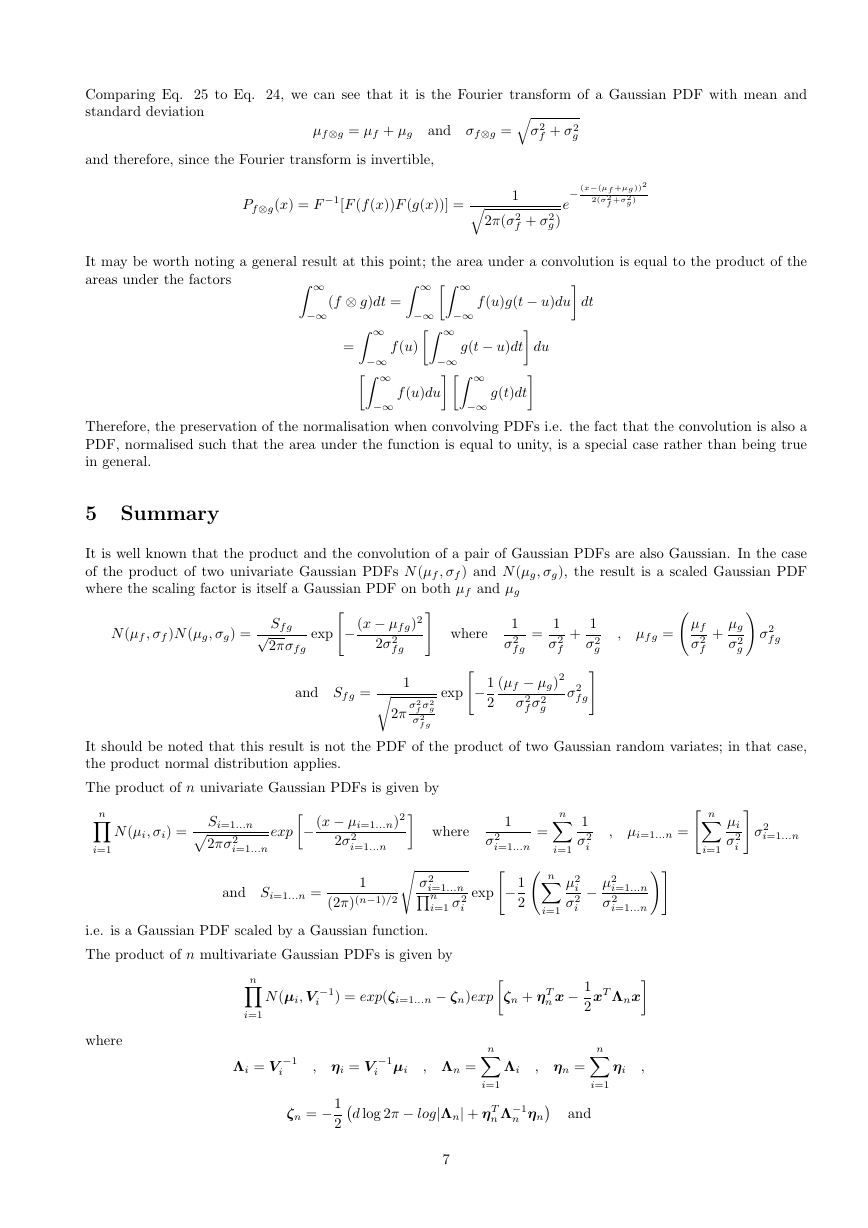
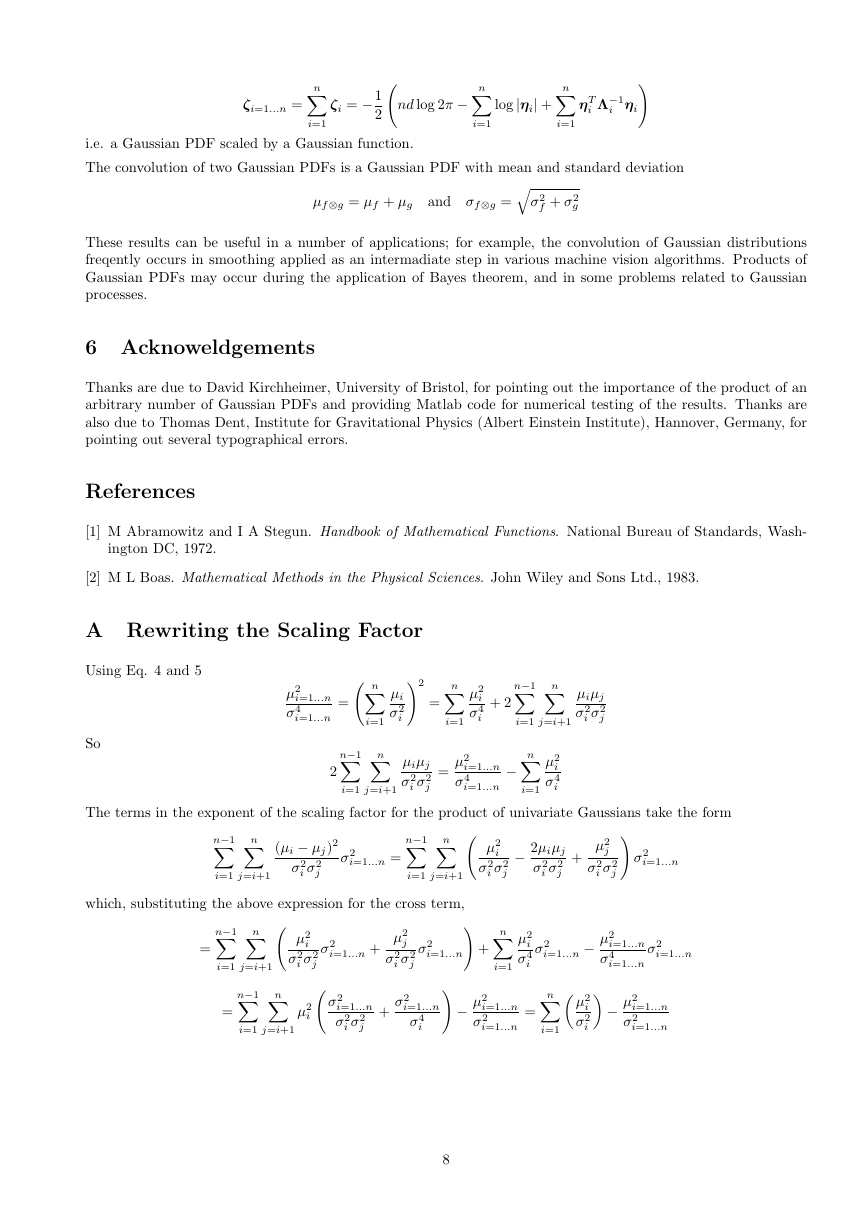








 2023年江西萍乡中考道德与法治真题及答案.doc
2023年江西萍乡中考道德与法治真题及答案.doc 2012年重庆南川中考生物真题及答案.doc
2012年重庆南川中考生物真题及答案.doc 2013年江西师范大学地理学综合及文艺理论基础考研真题.doc
2013年江西师范大学地理学综合及文艺理论基础考研真题.doc 2020年四川甘孜小升初语文真题及答案I卷.doc
2020年四川甘孜小升初语文真题及答案I卷.doc 2020年注册岩土工程师专业基础考试真题及答案.doc
2020年注册岩土工程师专业基础考试真题及答案.doc 2023-2024学年福建省厦门市九年级上学期数学月考试题及答案.doc
2023-2024学年福建省厦门市九年级上学期数学月考试题及答案.doc 2021-2022学年辽宁省沈阳市大东区九年级上学期语文期末试题及答案.doc
2021-2022学年辽宁省沈阳市大东区九年级上学期语文期末试题及答案.doc 2022-2023学年北京东城区初三第一学期物理期末试卷及答案.doc
2022-2023学年北京东城区初三第一学期物理期末试卷及答案.doc 2018上半年江西教师资格初中地理学科知识与教学能力真题及答案.doc
2018上半年江西教师资格初中地理学科知识与教学能力真题及答案.doc 2012年河北国家公务员申论考试真题及答案-省级.doc
2012年河北国家公务员申论考试真题及答案-省级.doc 2020-2021学年江苏省扬州市江都区邵樊片九年级上学期数学第一次质量检测试题及答案.doc
2020-2021学年江苏省扬州市江都区邵樊片九年级上学期数学第一次质量检测试题及答案.doc 2022下半年黑龙江教师资格证中学综合素质真题及答案.doc
2022下半年黑龙江教师资格证中学综合素质真题及答案.doc